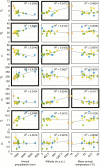Aridification as a driver of biodiversity: a case study for the cycad genus Dioon (Zamiaceae)
- PMID: 29155921
- PMCID: PMC5786249
- DOI: 10.1093/aob/mcx123
Aridification as a driver of biodiversity: a case study for the cycad genus Dioon (Zamiaceae)
Erratum in
-
Corrigendum: Aridification as a driver of biodiversity: a case study for the cycad genus Dioon (Zamiaceae).Ann Bot. 2018 Jan 25;121(1):193. doi: 10.1093/aob/mcx201. Ann Bot. 2018. PMID: 29304193 Free PMC article. No abstract available.
Abstract
Background and aims: Aridification is considered a selective pressure that might have influenced plant diversification. It is suggested that plants adapted to aridity diversified during the Miocene, an epoch of global aridification (≈15 million years ago). However, evidence supporting diversification being a direct response to aridity is scarce, and multidisciplinary evidence, besides just phylogenetic estimations, is necessary to support the idea that aridification has driven diversification. The cycad genus Dioon (Zamiaceae), a tropical group including species occurring from humid forests to arid zones, was investigated as a promising study system to understand the associations among habitat shifts, diversification times, the evolution of leaf epidermal adaptations, and aridification of Mexico.
Methods: A phylogenetic tree was constructed from seven chloroplast DNA sequences and the ITS2 spacer to reveal the relationships among 14 Dioon species from habitats ranging from humid forests to deserts. Divergence times were estimated and the habitat shifts throughout Dioon phylogeny were detected. The epidermal anatomy among Dioon species was compared and correlation tests were performed to associate the epidermal variations with habitat parameters.
Key results: Events of habitat shifts towards arid zones happened exclusively in one of the two main clades of Dioon. Such habitat shifts happened during the species diversification of Dioon, mainly during the Miocene. Comparative anatomy showed epidermal differences between species from arid and mesic habitats. The variation of epidermal structures was found to be correlated with habitat parameters. Also, most of the analysed epidermal traits showed significant phylogenetic signals.
Conclusions: The diversification of Dioon has been driven by the aridification of Mexico. The Miocene timing corresponds to the expansion of arid zones that embedded the ancestral Dioon populations. As response, species in arid zones evolved epidermal traits to counteract aridity stress. This case study provides a robust body of evidence supporting the idea that aridification is an important driver of biodiversity.
Keywords: Aridification; Dioon; Mexico; Zamiaceae; climate change; cycads; diversification; epidermal anatomy; habitat shift.
© The Authors 2017. Published by Oxford University Press on behalf of the Annals of Botany Company. All rights reserved. For permissions, please e-mail: journals.permissions@oup.com.
Figures





References
-
- Abouheif E. 1999. A method for testing the assumption of phylogenetic independence in comparative data. Evolutionary Ecology Research 1: 895–909.
-
- Andrew RL, Kane NC, Baute GJ, Grassa CJ, Rieseberg LH. 2013. Recent nonhybrid origin of sunflower ecotypes in a novel habitat. Molecular Ecology 22: 799–813. - PubMed
-
- Anthelme F, Abdoulkader A, Viane R. 2011. Are ferns in arid environments underestimated? Contribution from the Saharan Mountains. Journal of Arid Environments 75: 516–523.
Publication types
MeSH terms
LinkOut - more resources
Full Text Sources
Other Literature Sources
Medical
Research Materials

